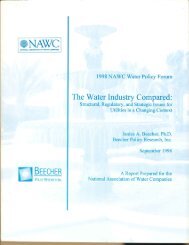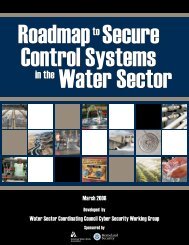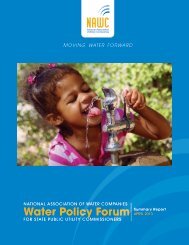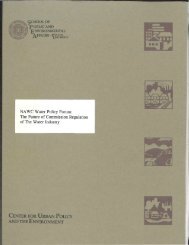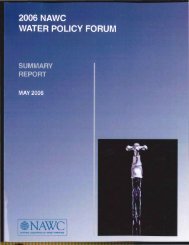Vol 36, No. 1 - NAWC
Vol 36, No. 1 - NAWC
Vol 36, No. 1 - NAWC
Create successful ePaper yourself
Turn your PDF publications into a flip-book with our unique Google optimized e-Paper software.
Regionalization/Consolidation of<br />
Water Systems in Missouri<br />
by Bill L. Sankpill and james A. Merciel, Missouri Public Service Commission<br />
presented at the Missouri Section and Kansas Section AWWA joint Conference, AprilS, 1995, Kansas City, Missouri<br />
Regionalization and consolidation of<br />
water systems is not a new idea. It has been<br />
going on for a long time. However, today,<br />
with the advent of the demands of the Safe<br />
Drinking Water Act (SDWA) as amended<br />
in 1986, combined with the fact that many<br />
water systems are 80 to 100 years old, a<br />
great number of water utilities are operating<br />
with inadequate systems. Water systems<br />
which may have been well designed<br />
and" state of the art" when they were new<br />
may now be inadequate to meet water quality<br />
and demand requirements. Water utilities<br />
with such systems may need to rehabilitate<br />
or even replace source of supply<br />
facilities as well as distribution mains,<br />
valves and hydrants. This is basic water<br />
system infrastructure replacement, and<br />
the issue has nationwide attention.<br />
In northeast, north-central, northwest<br />
and west-central parts of Missouri, ground<br />
water is very scarce or not available at all.<br />
The sources of supply for most of these<br />
areas are either shallow wells or small sur·<br />
face reservoirs. It is going to become very<br />
expensive co treat water from these supplies<br />
to meet new drinking water standards.<br />
Thus, the need exists for the development<br />
of regi onal water suppli es.<br />
Available sources of water include the<br />
Missouri and Mississippi Rivers, the alluvium<br />
along these rivers, U.S. Army Corps<br />
of Engineers reservoirs, or other relatively<br />
large impoundments. In these areas, a reliable,<br />
good-quality and adequate source<br />
of water, which can be treated at a reasonable<br />
cost, is available to supply water to<br />
service areas the size of several counties.<br />
What are the pros and cons of such a<br />
regional water supply? The pros are as fol·<br />
lows:<br />
1. Will provide a reliable, adequate, qual·<br />
ity source of water supply;<br />
2. Will make a public water system avail·<br />
able to more people, and encourage<br />
long·range planning;<br />
3. The fixed costs of operatio ns are<br />
e <strong>NAWC</strong>WATER<br />
spread over a large customer base;<br />
4. The larger regional suppliers can affo<br />
rd to hire a higher level of expertise<br />
and maintain a larger work force;<br />
5. Additional capacity provides another<br />
incentive for economic development;<br />
6. Local officials are not burdened with<br />
meeting State and Federal standards<br />
applicable to source of supply;<br />
7. Allows capital to be freed up in the<br />
small systems, which can then be used<br />
to improve distribution system infra·<br />
structure;<br />
8. Ftees up bonding capacity of small<br />
municipalities, which can then be used<br />
for other infrastructure needs such as<br />
streets, storm sewers, etc.;<br />
9. Provides an avenue for the state to as·<br />
sist local communities to cooperate for<br />
funding eligibility, encouraging long<br />
term areawide planning;<br />
10. Provides common goals for communities;<br />
11 . Requires less oversight of compliance<br />
review monitoring; and<br />
12. Provides a good avenue for private·<br />
public partnerships.<br />
The cons include:<br />
1. Some local control is lost;<br />
2. Small systems must meet requirements<br />
of the regional system such as pressure<br />
and hydraulic requirements;<br />
3. Rates will be increased, though not as<br />
high as for improvement of individual<br />
systems;<br />
4. Will require additional meetings and<br />
coordination activities to plan and<br />
implement regional systems; and,<br />
5. The "fear of change"-from the point<br />
of view of customers, and from utility<br />
officials and employees.<br />
A significant !Cfear of change" as pect of<br />
regionalization is impact on local jobs. The<br />
operator of a water plant eliminated by<br />
regionalization may experience a negative<br />
impact. A similar impact could be experi·<br />
enced by a utility manager or public works<br />
director. However, there are two points<br />
that need to be addressed. One is consid·<br />
eration of the positive impact<br />
regionalization can h ave on the entire<br />
community. Elimination of one or more<br />
jobs in the community unfortunately is<br />
something that must simply be weighed<br />
with all other considerations and not<br />
made an emotional issue. Still, it may be<br />
an emotional issue to some citizens and<br />
local officials need to keep this point in<br />
mind when making their decisions. But<br />
the second point is that changes resulting<br />
from reg ionalization would not always<br />
negatively impact local jobs. For example,<br />
the local operator may, well have the op·<br />
portunity to work in a new, well-designed<br />
facility instead of struggling with the old<br />
plant. Or, perhaps, the utility or community<br />
would decide to retain its people to<br />
work on other pressing matters such as distribution<br />
or other municipal services, especially<br />
if additional funds become available<br />
as described earlier. It may be human<br />
nature to fear change in our lives, whether<br />
it pertains to our jobs or our utility rates,<br />
but we must keep an open mind and ob·<br />
jectively evaluate the possibilities in order<br />
to serve our communities and ourselves<br />
in the best manner.<br />
Viability, a popular buzzword in the<br />
small water supply field, is a good reaso n<br />
for regionalization of water systems, since<br />
many small systems are not viable as stand·<br />
alone operations. Some small private utilities,<br />
for example, are not viable without<br />
being operated along with a teal estate or<br />
development business; some small municipalities<br />
could not operate a water utility<br />
without also providing additional city services.<br />
Regionalization of the source of<br />
supply can relieve a great deal of the burden<br />
on nonviable utilities. Besides<br />
regionalization of supply, consolidation of<br />
utilities provides the same viability advan·<br />
tage. Consolidation can either be limited<br />
co management and/or operation of sev·



